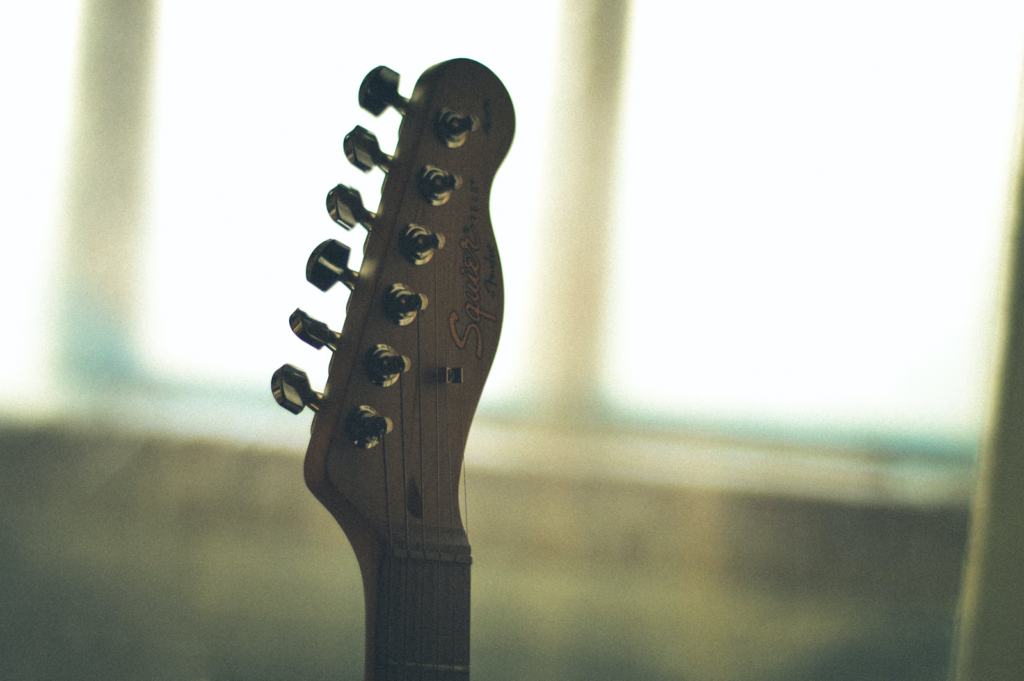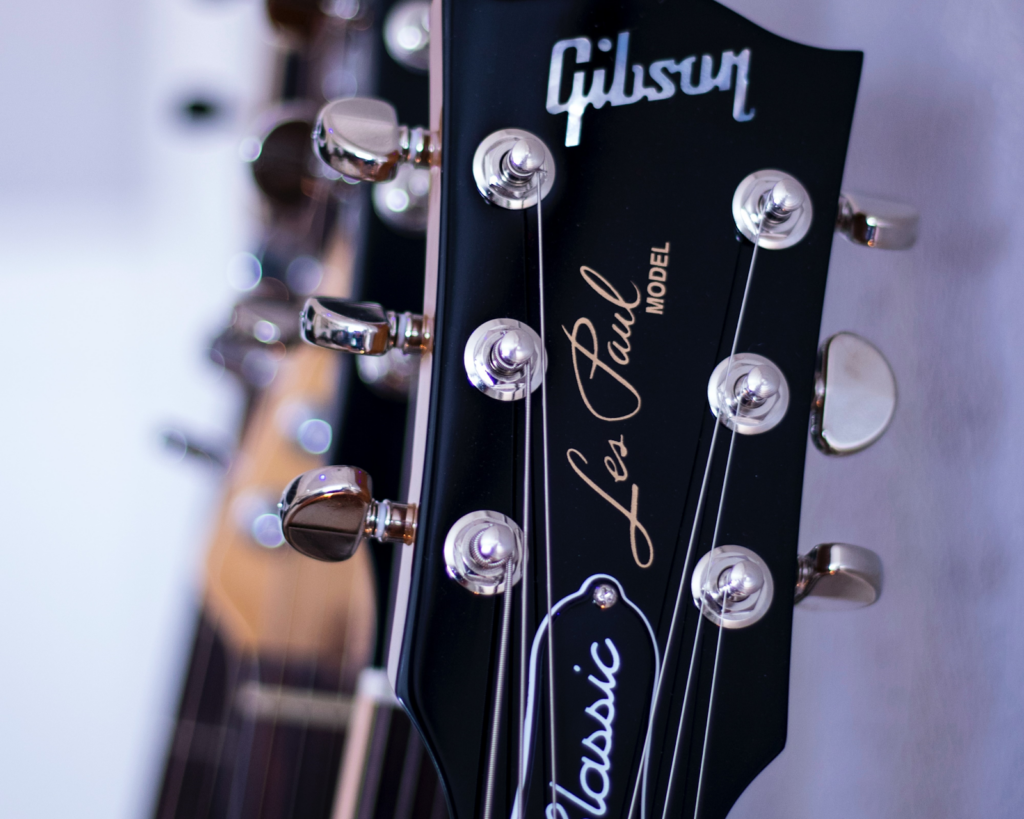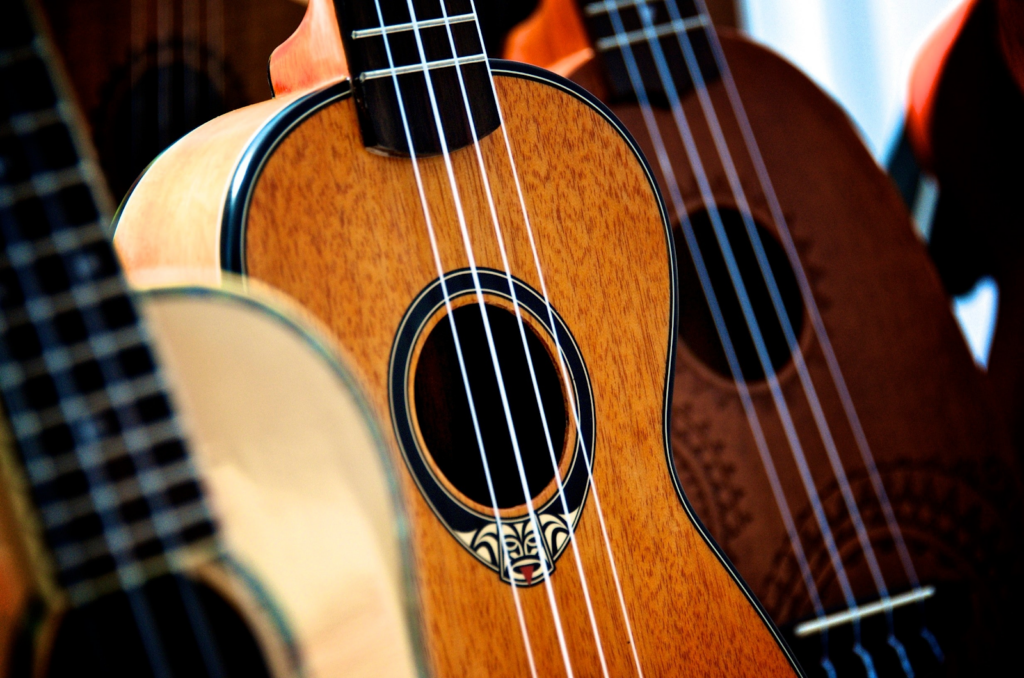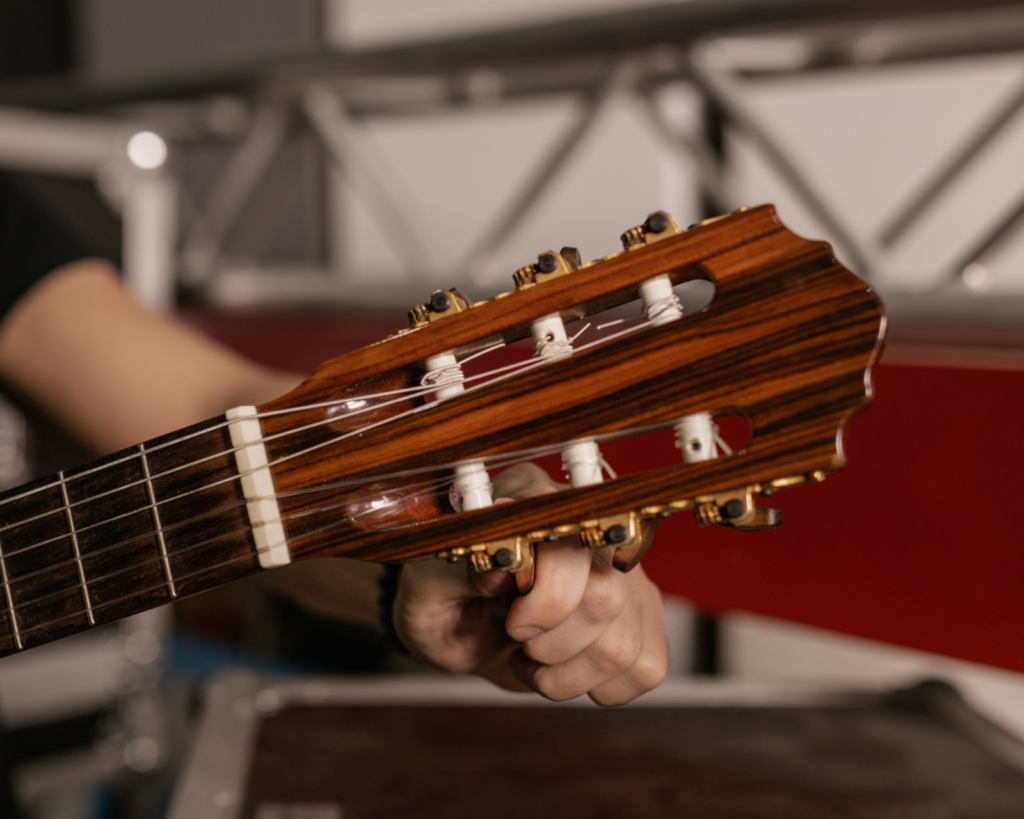The guitar headstock is not just a decorative piece; it plays a pivotal role in the instrument’s functionality, design, and overall aesthetics. Over the years, different guitar manufacturers have developed unique guitar headstock shapes, each with its rationale and effect on guitar playing.
We’ll delve into the world of guitar headstock shapes and explore the intricacies behind these iconic designs.
What is a Guitar Headstock?
The guitar headstock, often simply referred to as the “head,” is the uppermost part of the guitar neck. This essential component plays several pivotal roles in both the functionality and aesthetics of the instrument.
At a basic level, the guitar headstock houses the tuning pegs (or machine heads) that allow players to adjust the pitch of the strings. Each tuning peg corresponds to a string. By turning the pegs, the tension in the strings changes, adjusting their pitch and tuning the guitar. The headstock ensures that the strings are spaced appropriately as they pass over the nut and proceed down the neck of the guitar.
But the role of the headstock isn’t merely functional; it’s also a canvas of identity. Many manufacturers use the headstock design as a brand signature. For instance, the distinct shapes of Fender and Gibson guitars are instantly recognizable by their unique headstock designs. For many guitar enthusiasts, the shape and design of a guitar headstock are as iconic as the body shape of the guitar itself.
Furthermore, the design and angle of the guitar headstock can influence playability and tone. Different guitar headstock shapes can change string tension, break angle over the nut, and even the resonance of the instrument. Whether it’s a straight, angled, or headless design, each type of headstock imparts its unique characteristics to the guitar.
While it might seem like a small part of the instrument, the guitar headstock is a blend of engineering, art, and branding, all of which collectively define a significant aspect of the guitar’s identity and playability.

1. Straight (Flat) Headstock
The straight or flat headstock is, as the name suggests, completely flat without any angle. It’s commonly seen on Fender models, and this design makes it easy for string trees to be added, ensuring strings have a consistent break angle over the nut.
Overview
Design Genesis: One of the main reasons for the straight headstock shape was the ease of manufacturing. Fender, which predominantly makes flat headstocks, was among the first to mass-produce electric models. A flat headstock simplified the production process.
Playing Impact: Flat headstocks usually need string trees, especially on the 6-in-line tuner configuration, to maintain tension and reduce tuning instability.

2. Scarf Headstock
The scarf headstock is characterized by a joint somewhere below the headstock that attaches two pieces of wood. This design is a cost-effective way to create an angled headstock without using a larger piece of wood.
Overview
Why the Scarf?: It’s all about saving wood and resources. Manufacturers can use offcuts or smaller pieces of wood, joining them to create the necessary angle for the headstock.
Playing Impact: Scarf joint headstocks often have the strength and angle benefits of other angled headstocks but without the potential weak point that can sometimes occur at the nut with one-piece designs.
3. Angled (Tilted-Back) Headstock
Predominantly seen on Gibson guitars, the angled or tilted-back headstock offers a different guitar aesthetic and functionality. It provides a natural string break over the nut, eliminating the need for string trees.
Overview
Origins: This design has been a staple of Gibson for many years. The angle, typically around 17 degrees, provides enough downward pressure to ensure the strings sit properly in the nut slots.
Playing Impact: The tension and angle help in better tuning stability. However, they might be more prone to breakage if the guitar falls due to the stress concentration at the nut.

4. Reversed Headstock
As the name implies, a reversed headstock has the pegs on the opposite side. While often seen as an aesthetic choice, this design has functional implications as well.
Overview
Design Quirk or Purposeful?: Initially, many thought of reversed headstocks as merely a visual gimmick. However, they can change the string tension, especially on the lower strings, altering tonal characteristics and playability.
Playing Impact: With the pegs for the lower strings being farther away, they have a longer string length behind the nut, which can slightly alter the tone and feel.
5. Headless Guitar
The future or a fad? The headless guitar eliminates the traditional headstock altogether. Not just an aesthetic choice, headless designs can offer a range of playing and ergonomic benefits.
Overview
Evolution in Guitar Design: The headless design primarily aims to reduce the guitar’s weight and improve balance, especially for electric guitars.
Playing Impact: Without the weight of the headstock and tuning pegs, most headless guitars can feel more balanced. Tuning is usually done at the bridge, leading to a more streamlined look and feel.

6. Classical Guitar Headstock
The classical guitar headstock stands distinct from its electric and steel-stringed counterparts. With a rich heritage rooted in centuries of tradition, it’s much more than just a design choice; it’s a nod to the instrument’s storied past.
Overview
Historical Significance: The classical guitar, also known as the Spanish guitar, has been deeply influenced by centuries of Spanish luthier traditions. The design of its headstock is a tribute to these traditions and has remained relatively consistent over the years.
Design Specifics: Unlike the 6-in-line configuration commonly seen on electric guitars, this classic shape usually features three pegs on either side, sometimes referred to as a “3+3” or “4 2” configuration. This design often results in a slotted headstock where the tuning machines are located on the sides of the head, with the strings passing through the slots.
Playing Impact: The wider neck of these traditional guitars, combined with the headstock design, ensures that the nylon strings (which have a different tension compared to steel strings) have an appropriate break angle over the nut. This promotes better tuning stability and reduces string slippage.
Acoustic vs. Electric Model Headstocks
When diving into the world of guitars, you might quickly realize that acoustic and electric guitars, while sharing many commonalities, also have a whole host of differences. These differences aren’t confined merely to their sound or playability but extend to the structural and design aspects of the instruments, including their headstocks.
Let’s explore how the headstocks of these two guitar types differ and how the demands of each instrument shaped these designs.
Acoustic Guitar Headstocks
Acoustic guitars rely on the natural amplification of sound through their hollow bodies. This design paradigm affects every component, including the headstock.
Distinct Features
Slot-Head vs. Solid Headstock: Some acoustic guitars, especially classical ones, have a slot-head design where the pegs face backward, slotting into the headstock. This traditional design is rarer in modern acoustics but is still cherished by many for its classical appeal and purported tonal benefits.
Wider Spacing: Acoustic guitar headstocks often have wider spacing between pegs, especially on 3+3 configurations, to accommodate thicker string gauges and ensure smoother tuning.
Material & Construction: Typically made of solid wood to match the guitar’s neck, many believe this continuity of material enhances resonance and sustain.
Design Influence: The nature of acoustic guitars, with their emphasis on natural tone and resonance, means that headstock designs are often driven by traditional aesthetics and tonal enhancement. Material choice and a preference for more classical designs, like the slot head, reflect this influence.

Electric Guitar Headstocks
Electric guitars, on the other hand, primarily rely on electronic amplification. This shifts the focus from natural resonance to other factors, allowing for more varied headstock designs.
Distinct Features
Diverse Shapes & Configurations: Electric guitars showcase a wide variety of headstock shapes, from the 6-in-line configuration seen in many Fender guitars to the 4+2 or even more asymmetric designs.
Thinner and Sleeker: Generally, these headstocks are sleeker and may have narrower spacing, reflecting the typically lighter gauge strings used and the diverse design philosophies of electric guitar manufacturers.
Material Variation: While many are still made of solid wood, there’s a greater variety in laminates, veneers, and other materials in these headstocks, sometimes for aesthetic purposes and sometimes for added strength.
Design Influence: The electric guitar’s reliance on electronic amplification means that the headstock’s tonal influence is often perceived as less critical. This has given designers more freedom, leading to the wide variety of electric guitar headstock shapes we see today. Brands, aesthetics, and player ergonomics have heavily influenced these designs.

Brand Signatures & Trademark Battles
In the world of guitars, the headstock isn’t just a piece of wood that holds tuning pegs—it’s a canvas that carries the identity of a brand. Over the years, certain headstock shapes have become so iconic that they’re instantly associated with specific manufacturers. From Jackson Guitars and Music Man guitars all the way to Fender guitars, every brand has a specific look. Given the stakes, it’s no surprise that these shapes have been at the heart of numerous trademark disputes.
Let’s delve into some of the most famous battles and understand the role of the headstock in brand identity.
Fender vs. The World
Arguably, one of the most recognized headstock shapes in the guitar world belongs to Fender. The curvaceous design, especially of the Stratocaster, has become synonymous with the brand. However, today, Fender still faces threats to their brand due to cheaper counterfeit products.
Gibson’s “Open Book” Headstock
Another major player, Gibson, has seen its fair share of disputes, particularly around its famed “open book” or “dove-wing” headstock shape. Gibson successfully trademarked their headstock design. As a result, they’ve been aggressive in defending it.
Over the years, Gibson has taken legal action against various manufacturers who’ve produced guitars with similar headstock shapes. Brands like Ibanez, ESP, and Paul Reed Smith have all faced Gibson’s legal might at one point or another. Most of these disputes ended in settlements or slight redesigns to avoid further conflict. However, there are still many “Chibsons” available – counterfeits shipped from China.
The Essence of Identity
Why all these battles over a piece of wood? The answer lies in brand identity and differentiation. In a market crowded with countless manufacturers, having a distinctive headstock shape allows a brand to stand out. When a guitarist sees a specific headstock silhouette from across a room, they can immediately identify the brand, even before spotting the logo or any other distinguishing features.
Furthermore, these headstock designs carry with them a legacy and history. Guitars like the Fender Stratocaster or the Gibson Les Paul aren’t just instruments—they’re icons with storied pasts. The headstock shapes, therefore, aren’t just designs; they’re symbols of musical epochs, legendary players, and sonic revolutions.
Caring for Your Guitar Headstock
Like any finely crafted instrument, a guitar requires regular maintenance and care to keep it in optimal condition. While much attention is given to the body, frets, and strings, the headstock—a crucial component of the guitar—often gets overlooked. Proper care of the headstock not only ensures smooth tuning but can also prevent potential damage. Let’s dive into tips for maintaining your guitar’s headstock and discuss common repairs that can make your headstock feel like new again.
Maintenance Tips for the Headstock
Regular Cleaning: Just like with any stringed instrument, dust and sweat can accumulate on the headstock, particularly around the pegs. Use a soft, lint-free cloth to gently wipe down the headstock after each play. For deeper cleaning, slightly dampen the cloth, but ensure it’s not wet, as excessive moisture can damage the wood or finish. Make sure to get in the nut grooves, where a lot of dirt can build up over years of playing.
Tuning Peg Maintenance: Over time, pegs can become stiff or loose. Periodically check for smooth operation. If they feel tight, a drop of lubricant (preferably guitar-specific) can ensure smooth rotation. If they’re loose, tightening the screw on the peghead can help.
Protecting the Finish: Depending on the finish of your headstock, consider using guitar polish to maintain its shine and protect it from potential discoloration or damage. Always use products designed specifically for guitars to avoid damaging the finish.
Storage: Store your guitar in a case or on a wall hanger when it’s not in use. If you’re using a wall hanger, make sure it doesn’t exert undue pressure on the headstock. This can prevent accidental dings or even breaks.
Regular Inspections: Periodically inspect the headstock for cracks, especially near the nut or along the sides of the headstock. Early detection can prevent minor issues from becoming major problems.

Common Headstock Repairs
While good headstocks are built to last, they can suffer damage. Here are some common repairs:
Broken Headstock: These breaks are especially common with guitars that have angled headstocks, like many Gibson models. They can result from falls or even rapid temperature changes. While a broken headstock might look catastrophic, in the hands of a skilled luthier, it can often be repaired to be as strong as—or even stronger than—before.
Stripped Tuning Peg Holes: With repeated string changes or tuning adjustments, the holes for the pegs can become stripped. Repair might involve filling and redrilling the hole or using larger pegs.
Loose or Damaged Tuning Pegs: Over time, pegs can wear out, or their gears can become damaged. Replacing them is relatively straightforward and can often be done by the guitarist, but ensure the replacements are of good quality to maintain tuning stability.
Cracks and Finish Damage: Minor dings or cracks can occur, especially on the edges of the headstock. Depending on the finish and the severity, repairs might range from simple touch-ups to more extensive refinishing.
An Angled Headstock Requires Special Care
Angled headstocks have a distinct break angle over the nut, which adds tension to the strings. Although this improved the sound, the design can make them more susceptible to breaks, especially if the guitar falls or is subjected to pressure.
While many breaks are repairable, prevention is key, especially when it comes to an angel headstock. Always handle guitars with care, and be mindful when placing them on stands, leaning them against walls, or using a standard guitar hanger.
Guitar Headstock Shapes: Frequently Asked Questions
Does the shape of the headstock matter?
Yes, the shape of the headstock does matter. While aesthetics play a role in its design, the shape can also affect several functional aspects of the guitar. The headstock shape can influence the break angle of the strings over the nut, which in turn affects string tension and tuning stability.
Different headstock shapes can also change the guitar’s overall balance and weight distribution. Furthermore, the arrangement of the tuning pegs, determined in part by the headstock shape, can influence how easy it is for a guitarist to tune the instrument.
What is the best headstock design?
There isn’t a definitive “best” headstock design, as it largely depends on individual preferences and specific requirements. Some guitarists might prefer the straight headstock of Fender guitars for its iconic look and simplicity, while others might lean towards the angled design of Gibson guitars for its natural string break and tuning stability. Others might opt for modern designs, like headless guitars, for their ergonomic benefits. It’s essential to understand the characteristics and benefits of each design and choose one that aligns with your playing style and aesthetic preferences.
Why are Fender headstocks shaped like that?
Fender headstocks, particularly the ones with the straight (or flat) design, have become emblematic of the brand. The design was initially chosen for its ease of manufacturing, especially during the early days of mass-produced electric models. The straight design simplified the production process and reduced costs. As for its unique shape and contour, Leo Fender wanted to distinguish his guitars from other brands, leading to the iconic design we recognize today. Over time, this shape not only became synonymous with Fender guitars but also played a role in the overall balance and resonance of the instrument.
Final Thoughts
From Fender’s iconic straight headstocks to the streamlined designs of headless guitars, the world of guitar headstock shapes is rich and varied. Each design, whether driven by aesthetics, functionality, or both, offers guitarists a different experience. As you navigate the world of guitars, understanding the nuances of these headstock shapes can deeply enrich your appreciation of this timeless instrument.


